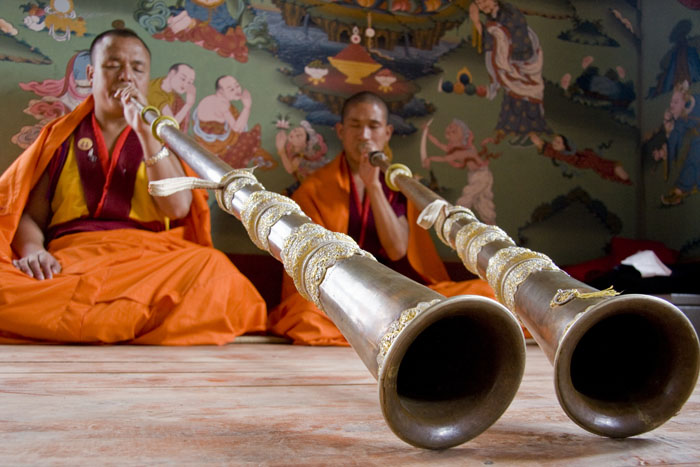Losar: Community Building and the Bhutanese New Year

The Bhutanese New Year’s festival, called Losar, is celebrated between February and March depending on the lunar calendar. In 2013 Losar falls on February 11-12. This festival holiday is marked by ritual feasting and family gatherings, as well as offerings of thanksgiving and for an auspicious year to come.
The specifics of Losar celebrations differ between regions in Bhutan and from similar Losar celebrations in neighboring Tibet. The food eaten during Losar and its preparation, presentation, consumption, and symbolic meaning are highly important traditional rituals that serve to reinforce community ties and Bhutanese identity and culture.
The modern celebration of Losar in Bhutan originated in 1637, when Shabdrung Ngawang Namgyal (1594-1651), the unifier of Bhutan, marked the completion of the famous Punakha dzong (temple) with an inaugural celebration. Bhutanese came from all over the country to bring offerings of produce from their various regions, a tradition that is still reflected in the wide variety of foods consumed during the ritual Losar meals.
Often, Losar celebrations include a traditional morning meal, which is timed to coincide with the rising of the sun, as well as a midday meal and afternoon snack. Food such as fried biscuits (tshos); mandarins; diced sugar cane; fermented rice (changkoi); various stews, porridges, and cheeses; different teas and special sweets (shudre) are all traditionally consumed. Sugar cane and green bananas are considered auspicious foods, the presence of which helps to ensure the New Year will be a good one.
Bhutanese hold archery competitions (archery is their national sport), and play darts and other games. Families picnic, people dance and sing, and offerings are made.

In past years, Losar reinforced communal ties and hierarchical social relationships. Wealthy Bhutanese families would provide a ritual feast for the community—providing food, entertainment, and offerings for servants, townspeople, dependents, and other community members. During Losar, people ate special foods—delicacies available only during the festival and purchased by the wealthy. Many Bhutanese also received new clothes at Losar—a once a year event.
Traditional rituals of Losar ensured that wealthy “patrons” were assured the loyalty of their dependents. Friends and equals reaffirmed goodwill, and dependents sent gifts and offerings to their patrons to demonstrate the continuation of their relationship. Identity was reinforced through the traditional roles each member of the community was expected to fulfill. That being said, Losar was also a time when the wealthy families and their dependents gathered together to eat, sing, dance, and play games together.
Society in Bhutan has changed considerably, since the 1950s especially. Bhutan transitioned from a traditional monarchy to a democratically elected parliament in 2008, which coincided with the Bhutan: Land of the Thunder Dragon program at the Smithsonian Folklife Festival. Food that was once rare or extremely expensive is now available year-round, and clothes can be purchased at any time. Some of the unique traditions that made Losar special for past generations no longer hold the same meaning. For example, today the celebration of Losar is no longer shaped by semi-feudal social dynamics.
It is, however, still a holiday of feasting, singing, dancing, archery, and offerings. It is a special time when Bhutanese gather and renew their ties with friends, family, and the wider community, celebrating the cultural traditions of Bhutan and hoping for an auspicious New Year together. As demonstrated during the 2008 Bhutan: Land of the Thunder Dragon Folklife Festival program, Bhutanese strongly value their heritage, traditions, and culture.




James Mayer is an intern at the Smithsonian Center for Folklife and Cultural Heritage. He was a Fulbright Fellow in Turkey for the 2011-2012 academic year and is a graduate of Macalester College, where he studied History and Classics.
References
Ardussi, John, and Françoise Pommaret. Bhutan: Traditions and Changes. Leiden, the Netherlands: Brill Academic Publishers, 2007. eBook Collection (EBSCOhost), EBSCOhost (accessed February 1, 2013).
Choden, Kunzang. “Lo Gsar Celebration: the Significance of Food in the Noble and Religious Family of O Rgyan Chos Gling (Central Bhutan).” In Bhutan: Traditions and Changes, edited by John Ardussi and Françoise Pommaret, 27-43. Leiden, the Netherlands: Brill Academic Publishers, 2007. eBook Collection (EBSCOhost), EBSCOhost (accessed February 1, 2013).
“National Holidays of Bhutan | Water Female Snake Year 2013.” Bhutan Tourism Corporation, Ltd. and Far Flung Places LLC. (accessed February 1, 2013)
Scott, Preston. “Bhutan at the 2008 Smithsonian Folklife Festival.” Talk Story 34,(Fall 2008): 3-4,19.
Scott, Preston. “Restaging Bhutan.” Talk Story 35 (Spring 2009): 6.
“Tourism Council of Bhutan.” Tourism Council of Bhutan (accessed February 1, 2013)

